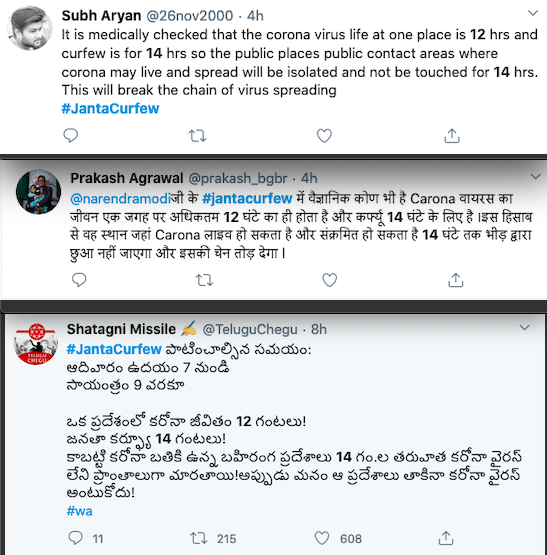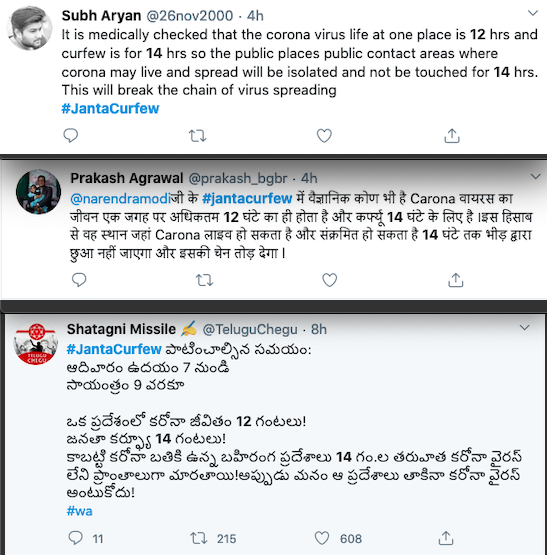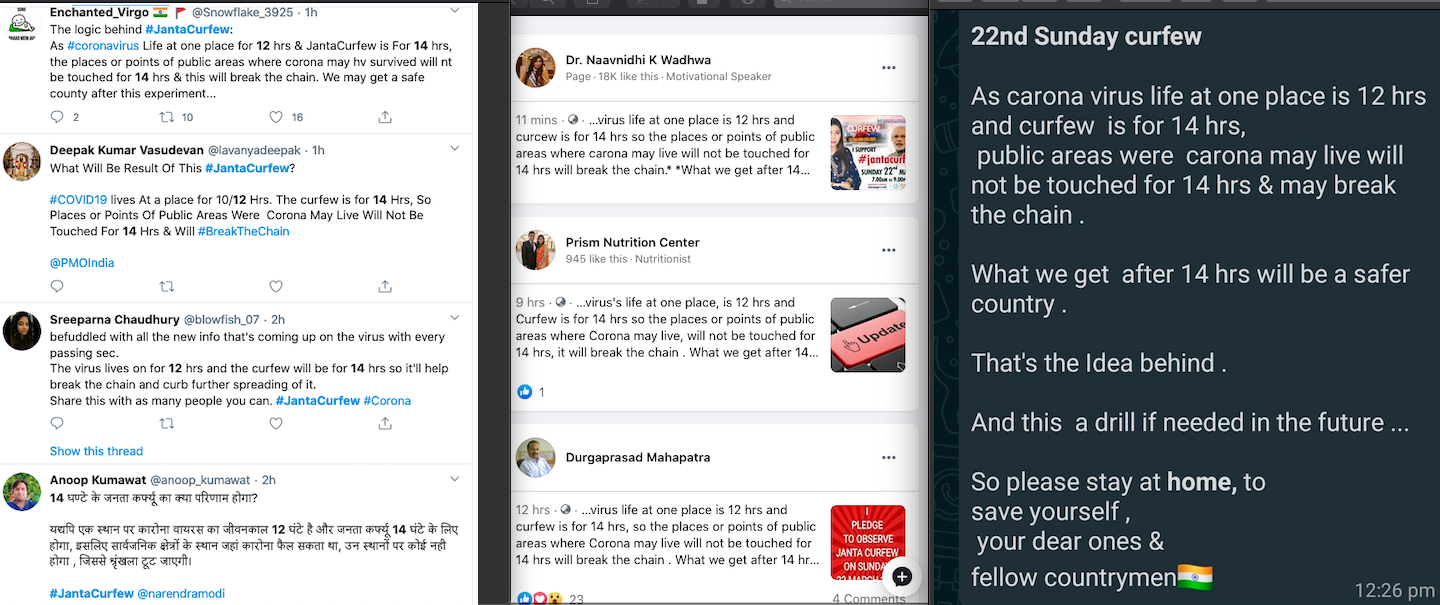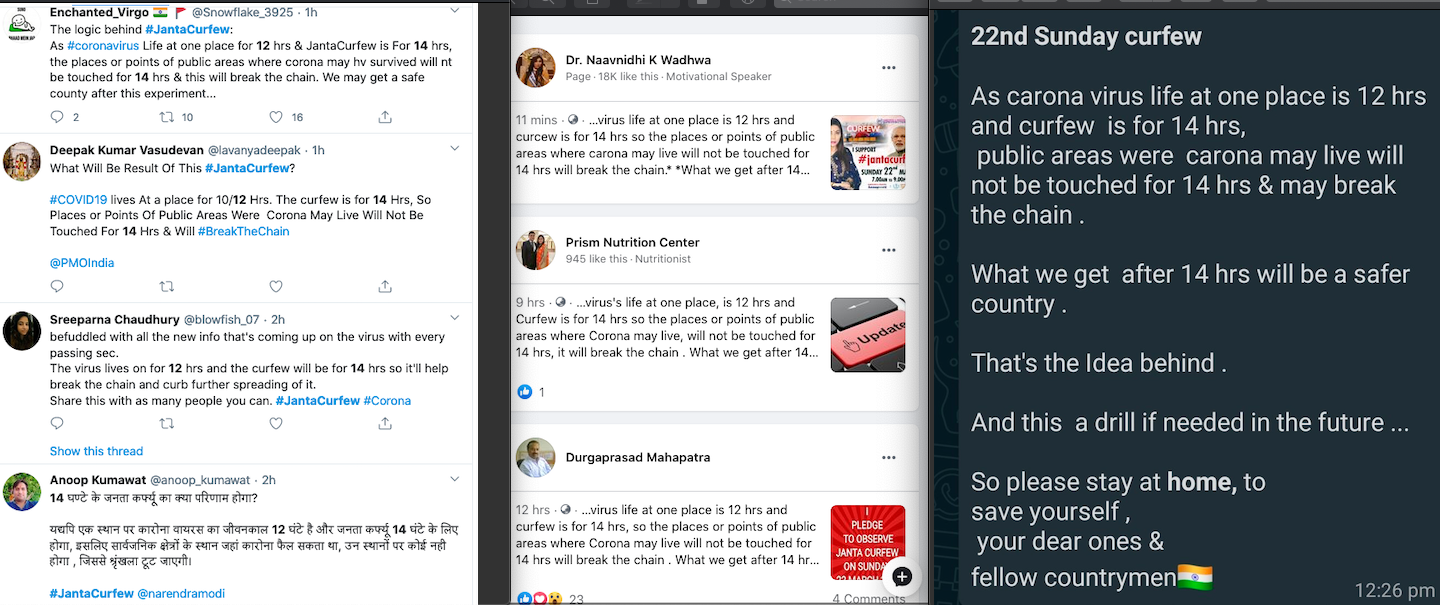On March 19, Prime Minister Narendra Modi gave a 29-minute address to take precautionary measures including observing a ‘Janta Curfew’ on March 22 from 7 AM to 9 PM to prevent the spread of the coronavirus in India.
Since then, several social media users have posted a text claiming that the coronavirus has a life cycle of 12 hours and a 14-hour curfew will help to break the chain and curb the further spread of the virus. This text is viral in English, Hindi and Telugu along with the hashtag #JantaCurfew.


The viral message has been shared on Twitter, Facebook and WhatsApp.


VERDICT
False:
- Virus can survive on surfaces for upto 3 days.
- Infected individuals can infect others for upto two weeks.
FACT-CHECK
A viral infection can be transmitted from one individual to another in multiple ways.
1) Direct: From one individual to another individual either via means of touch, or if the infected individual coughs or sneezes in close vicinity of another person.
2) Indirect: When an infected individual touches a surface, and another individual touches the same surface.
In the course of this article, we will demonstrate that a 14-hour self-imposed curfew will not break the cycle of infection as the coronavirus persists 2-3 days later on surfaces. However, social lockdown is an effective strategy for reducing new infections that flattens the curve.
Infected individual can pass the infection for upto two weeks
The novel CoV infection has a high incubation rate. The scientists at Imperial College, UK estimate that each coronavirus patient infects on average 2.6 others, making it almost as infectious as yearly influenza outbreaks. While the common influenza virus has a short incubation period and is self-resolving, the 2019-nCoV can be incubated for up to two weeks, hence increasing its chances to infect other people. So, someone who is infected with CoV would be able to pass it on to someone else till upto two weeks, even if the former isn’t yet displaying any symptoms.
Coronavirus can be detected on surface for upto 3 days
Alt News Science recently published an elaborate fact-check regarding how long can coronavirus live on various surfaces. Research (Doremalen et al 2020) published in the New England Journal of Medicine conducted by American scientists (preprint here) suggests that the new coronavirus (COVID-19) can live in the air for several hours and on some surfaces for as long as 2-3 days. They tested the virus by spraying into the air by a nebuliser mimicking the coughing action of an infected person. They found that it could be detected up to a minimum of 3 hours later in the air, up to 4 hours on copper surfaces, up to 24 hours on cardboard and up to 2-3 days on plastic and stainless steel surfaces.

The longevity of the virus was determined by studying the decay time or half-life of the virus, which is the time it takes for it to reduce in 50% tissue-culture infectious dose (TCID50) per litre of air. It was determined that the virus stayed on cardboard, stainless steel and plastic for the longest period, in comparison to copper and aerosol droplets.
On average, the half-life of the virus on plastic surface was the highest, with an average of 15.9 hours (high 19.2 hours), copper was lower 3.4 hours (high 5.11 hours), and stainless steel was 13.1 hours (high 16.1 hours). No research was conducted on fabric at all.
The study also suggests that the virus can spread through the air, from touching things that were contaminated by those who are infected, and through direct human contact. The virus was formerly known as HCoV-19, but is referred to as SARS-CoV2 in this study as the comparison of longevity was in comparison with the virus found in the previous coronavirus outbreaks, known as SARS-CoV or SARS-CoV1 in the study quoted above.
CONCLUSION
Thus, an individual infected with coronavirus can pass on the infection to another person for upto 14 days. Also, the coronavirus could be detected up to 2-3 days on plastic and stainless steel surfaces. The results from this study indicate that the coronavirus can be transmitted through aerosols (clusters of the virus in the air) aerosol and fomites (objects such as plastic, steel, other metals contaminated with the virus) are plausible, as the virus can remain viable in aerosols for multiple hours and on surfaces up to days. Hence, a 14 hour self-imposed curfew cannot break the cycle of infection as it is being claimed on social media.
Independent journalism that speaks truth to power and is free of corporate and political control is possible only when people start contributing towards the same. Please consider donating towards this endeavour to fight fake news and misinformation.
To make an instant donation, click on the “Donate Now” button above. For information regarding donation via Bank Transfer/Cheque/DD, click here.
Dr. Sumaiya Shaikh | Radio Free (2020-03-21T08:19:12+00:00) Social distancing is imperative but 14-hour ‘Janta curfew’ will not break the cycle of infection. Retrieved from https://www.radiofree.org/2020/03/21/social-distancing-is-imperative-but-14-hour-janta-curfew-will-not-break-the-cycle-of-infection/
Please log in to upload a file.
There are no updates yet.
Click the Upload button above to add an update.